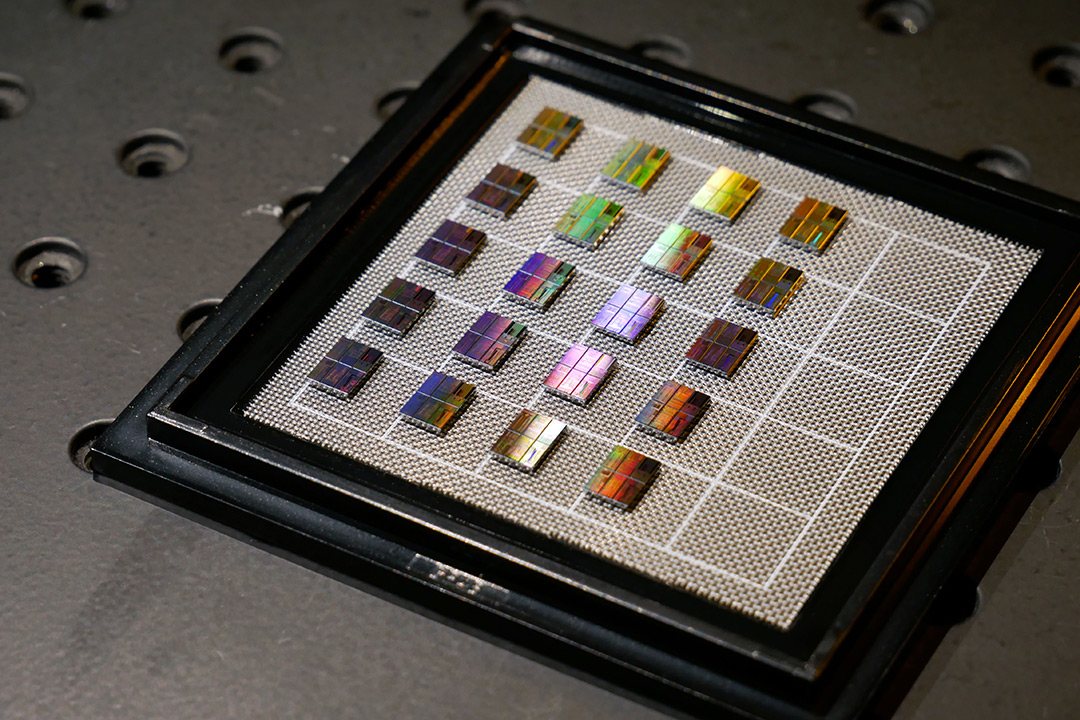RIT gets grant to advance computer architectures
Use of photonic integrated circuits to design neural network technologies could improve speed and energy consumption
Stefan Preble
Photonic chips designed by Stefan Preble’s Integrated Photonics Group and AIM Photonics partners.
Researchers at Rochester Institute of Technology will use photonic integrated circuit technology to improve the processing speed and energy consumption of brain-inspired computing techniques. Photonics, an emerging technology with wide-ranging potential, is essential to the nation’s manufacturing capabilities in areas such as high-speed data and telecommunications.
The university received $422,733 from the National Science Foundation for “PIC: Hybrid Silicon Electronic Photonic Integrated Neuromorphic Networks,” a multiyear project to advance neuromorphic computing using photonic circuits.
Neuromorphic computing, sometimes referred to as brain-inspired computing, is a sub-field of artificial intelligence where the physical, neural network architecture and its complex processing mechanisms are inspired by the learning mechanisms in the human brain. This type of architecture is currently developed using electronic integrated circuits, and the research team will be applying similar methods using photonic devices.
The new, neuromorphic system will leverage the advantages of both electronics and photonics to achieve higher performance and speed for devices as well as lower energy consumption. Photonic implementations of neural networks offer an advantage because light can easily perform computational tasks that are traditionally challenging to do in electronic-only implementations, said Stefan Preble, who will co-lead the research team.
“Electronic-only hardware, such as CMOS—a widely used type of semiconductor—is not suitable for high bandwidth applications critical to our modern information world. But the internet is powered by photonic technologies—lasers, electro-optic modulator and photodetectors—because of light’s high bandwidth, speed and low energy consumption. This project aims to realize high performance neural networks using light,” said Preble, professor of microsystems engineering in RIT’s Kate Gleason College of Engineering. He will be joined by Dhireesha Kudithipudi, professor of computer engineering and an expert in neuromorphic computing and artificial intelligence applications.
In order to construct the neural networks for photonic chips, the team will build upon known capabilities of electronics to overcome the challenges of establishing better memory and amplification. This hybrid approach, where electronics and photonics would be integrated together, enables the investigation of, and solutions for, the broadest class of problems in the evolution of improved photonic chips.
RIT is one of three universities within the AIM Photonics organization to receive recent NSF funding for collaborative projects. Others include:
- The University of California-San Diego, which will prototype and test miniaturized and mobile platform-embedded spectrometers.
- University of Delaware researchers are developing new heterogeneous manufacturing processes for photonic devices using several new materials.
Project outcomes could impact applications for autonomous systems, imaging and vision systems, information networks, cybersecurity, robotics and other high bandwidth applications. The work is focused on the design of photonic circuit architectures, enhanced processes for manufacturing complex photonic devices and incorporating next-generation computing capabilities.
Aspects of the RIT project will take place at the university, with contributions from researchers in its Future Photon Initiative—a cross-disciplinary team that collaborates with external university groups, industry and national laboratories to develop and commercialize new photonic device technology—and CHAI, the Center for Human-Aware Artificial Intelligence, an interdisciplinary artificial intelligence research team at the university. Additional work will take place at the AIM Photonics Test, Assembly and Packaging (TAP) facility located in Rochester, N.Y., and at the AIM Photonics site at SUNY Polytechnic Institute in Albany, N.Y. The project is an interdisciplinary activity that will provide technical training for future science and engineering professionals. There will be outreach activities that bring the research to K-12, undergraduate and graduate students. Students from underrepresented backgrounds will be actively engaged by providing lab visits with hands-on activities. Information and results from the work will be included in AIM Photonics Academy, the educational arm of the organization.













